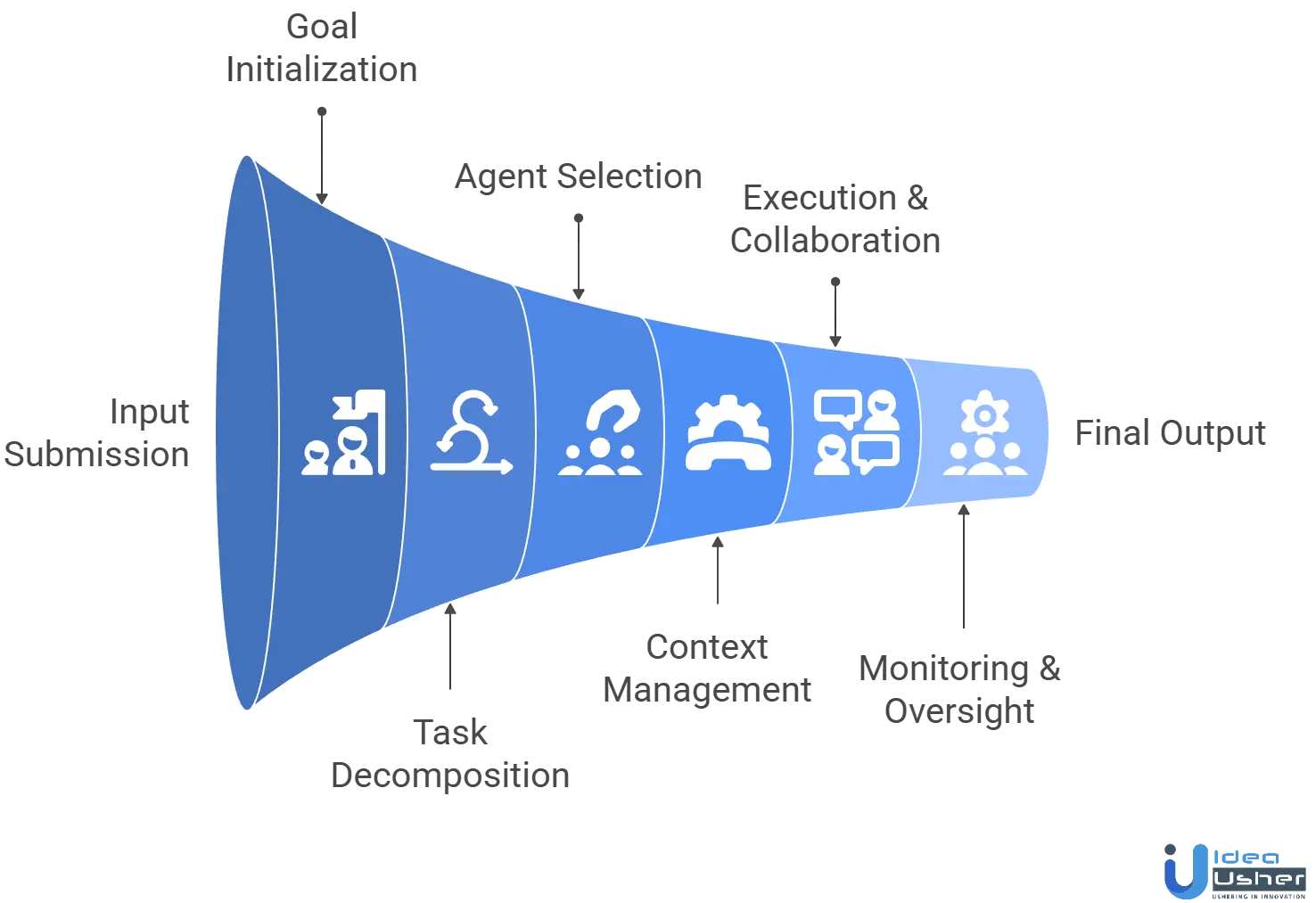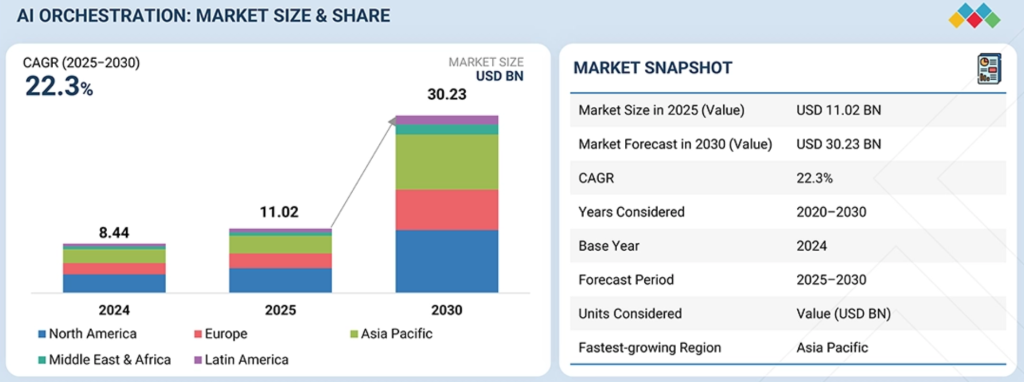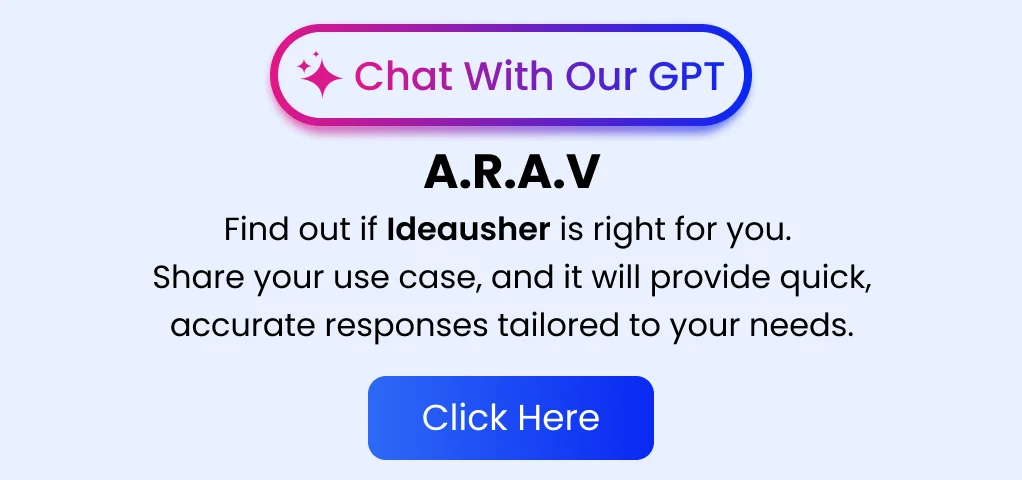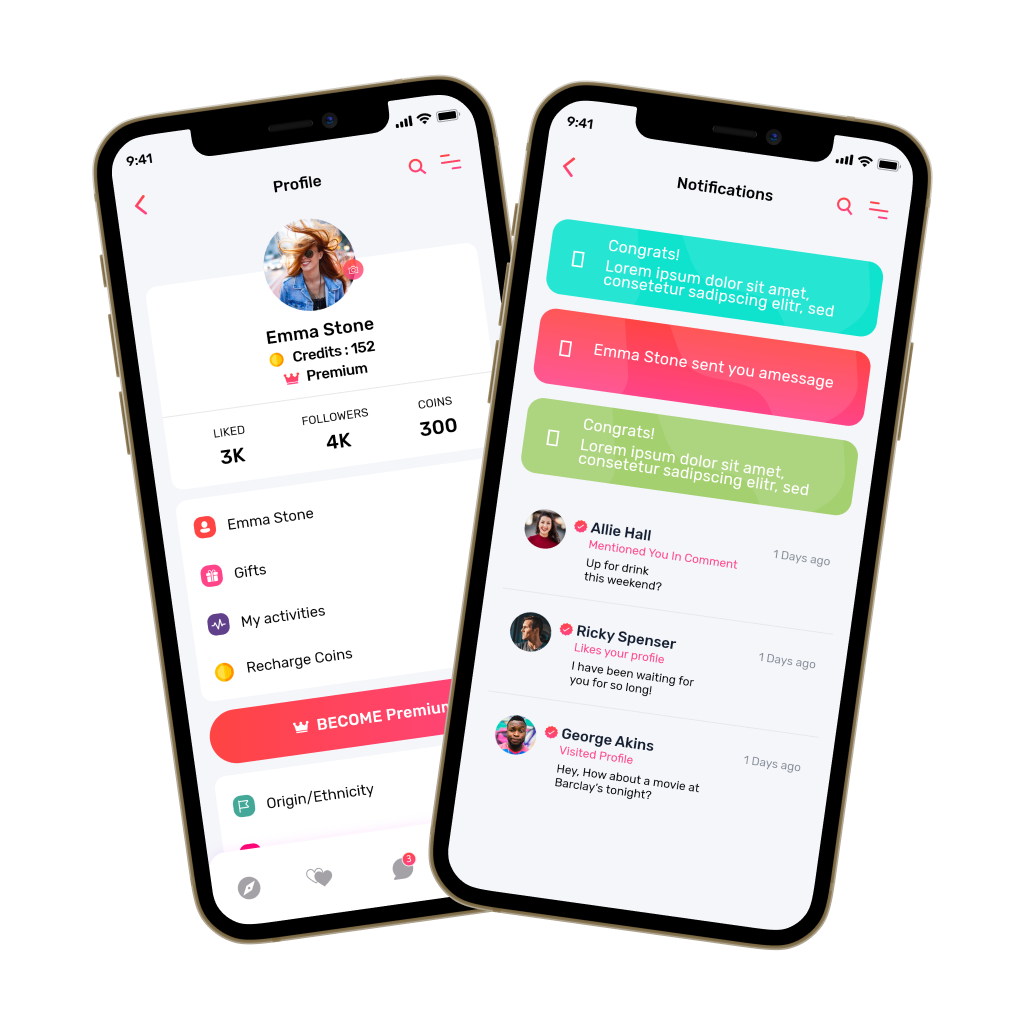Enterprises today are dealing with an ever-growing ecosystem of AI tools and automated processes. Managing multiple intelligent agents across different departments, tasks, and workflows can quickly become overwhelming. Without coordination, these systems may become inefficient, make mistakes, or miss important opportunities. AI agent orchestration helps streamline and connect these systems, making sure they work together instead of separately.
By building a robust orchestration engine, enterprises can coordinate multiple AI agents to perform complex workflows, make real-time decisions, and share insights across teams. These engines leverage advanced scheduling, dependency mapping, and centralized monitoring, enabling AI agents to communicate, collaborate, and scale in a controlled and intelligent manner.
In this blog, you’ll explore how to develop AI agent orchestration engines for enterprises, including key features, architecture, and tech stacks. If someone wants to launch an AI agent orchestration platform, with over years of expertise, IdeaUsher will help you to create a cohesive system that transforms scattered AI tools into a unified, high-performing enterprise solution.

What is an AI Agent Orchestration Engine?
An AI Agent Orchestration Engine is a software system designed to coordinate, manage, and optimize the interactions between multiple autonomous or semi-autonomous AI agents, tools, and workflows to achieve complex objectives. It acts as the central “conductor” that ensures each agent performs its task in the right sequence, with the right data, and in alignment with an overarching goal.
In essence, the orchestration engine transforms a collection of independent agents into a cohesive, goal-driven ecosystem capable of executing multi-step processes, adapting dynamically to new inputs, and maintaining traceability across every action.
At its core, an orchestration engine handles three essential functions:
- Task routing & coordination: assigning the right agent or tool to the right subtask at the right time.
- Context & state management: maintaining shared information across agents so each one acts with full awareness of prior steps.
- Integration & governance: connecting agents with external systems, enforcing policies, and ensuring human oversight when required.
AI Agent Orchestration Engine vs. Single-Agent Systems
AI Agent Orchestration Engines enable multiple agents to work together toward complex goals, while single-agent systems operate independently on specific tasks. The table below outlines their key differences in scope, functionality, and adaptability.
| Aspect | AI Agent Orchestration Engine | Single-Agent System |
| Scope of Functionality | Multi-agent, multi-step & goal-oriented across domains and systems. | Narrow, task-specific & usually confined to a single function. |
| Coordination | Central controller that sequences, routes, and manages agent & system interactions. | Operates independently, without coordination or interaction with other agents. |
| Context Management | Maintains shared state, memory, and contextual continuity across all agents and process steps. | Context is limited to the tool’s current session or single operation. |
| Scalability | Highly scalable, integrate new agents or replace existing ones without disrupting the system. | Limited scalability, expanding functionality often requires rebuilding or retraining the model. |
| Complexity of Tasks | Handles interdependent, multi-phase processes involving data exchange and decision-making among agents. | Suited for discrete or repetitive tasks with clear boundaries. |
| Governance & Compliance | Includes auditing, monitoring, and human-in-the-loop oversight for controlled execution. | Typically lacks built-in governance or traceability mechanisms. |
| Integration Capability | Connects with diverse external systems, APIs, and databases to support end-to-end workflows. | Usually restricted to a single environment or specific integration. |
| Resilience & Adaptability | Detects agent failures, reroutes tasks, and dynamically adapts to new information. | Dependent on predefined logic; limited adaptability to changing contexts. |
| Use Cases | Enterprise process automation, AI-driven decision orchestration, multi-domain data processing. | Chatbots, document classification, image recognition, or text generation in isolation. |
How an AI Agent Orchestration Engine Works?
An AI Agent Orchestration Engine coordinates specialized AI agents to achieve complex goals by planning, sequencing, and managing their contributions. It ensures actions are correctly ordered, contextual, and yield verifiable results.
For example, a banking platform uses AI agents to automate loan processing from application to approval and customer communication.
Here’s how the orchestration engine makes that process seamless and efficient:

1. Goal Initialization
The workflow begins when a new customer submits a loan application. The orchestration engine identifies the high-level objective “process and approve the loan” and prepares to coordinate the various AI agents involved.
Example: The engine processes a loan request by collecting applicant details, verifying documents, assessing creditworthiness, approving, and notifying the customer.
2. Task Decomposition & Planning
The orchestration engine breaks down the overall goal into structured subtasks and determines the optimal order of execution. It maps each task to the most relevant agent or tool.
Example:
- Document Verification Agent → Validate submitted income proof and ID documents.
- Credit Scoring Agent → Retrieve credit history and calculate a risk score.
- Risk Assessment Agent → Analyze repayment capacity using internal financial data.
- Decisioning Agent → Determine loan approval or rejection.
- Notification Agent → Send results to the customer and update records.
3. Agent Selection & Invocation
Once the workflow is planned, the orchestration engine dynamically selects the most suitable agents to execute each subtask and triggers them in sequence or parallel, depending on dependencies.
Example: The engine first activates the Document Verification Agent, providing it with the applicant’s uploaded documents and validation parameters.
4. Context & State Management
Throughout the process, the orchestration engine maintains a shared context storing relevant data, agent outputs, and workflow state. This ensures that all agents operate with the right information and no redundant actions occur.
Example: When document verification completes, results are stored in shared state. The Credit Scoring Agent then automatically accesses verified applicant data without re-requesting it.
5. Execution & Collaboration
The agents carry out their individual functions, while the orchestration engine coordinates their collaboration and data exchange. It ensures that every output becomes a valid input for the next step.
Example: After calculating the credit score, the Risk Assessment Agent uses it and income data to assess repayment potential. The Decisioning Agent then determines approval status.
6. Integration with External Systems
The orchestration engine connects with third-party services, internal databases, and APIs to facilitate real-time data exchange and process execution.
Example: It interfaces with external credit bureaus, fraud detection APIs, and the bank’s core system to fetch or update information as the loan application progresses.
7. Monitoring & Human Oversight
The orchestration engine continuously monitors workflow progress, enforces compliance policies, and manages exceptions. If a task requires judgment or review, it can automatically route it to a human specialist.
Example: If the risk assessment shows conflicting data or a borderline score, the engine pauses the automated process and assigns the case to a loan officer for manual review, ensuring regulatory compliance.
8. Aggregation & Final Output
Once all agents complete their tasks, the orchestration engine aggregates their outputs, validates the final decision, and delivers the result through the appropriate channel.
Example: After approval, the engine triggers the Notification Agent to email the customer, update the CRM with loan details, and record all steps for auditing.
Use Cases of AI Agent Orchestration for Enterprises
AI Agent Orchestration connects specialized agents to coordinate complex, multi-step tasks. Across industries, it enables automation that is faster, smarter, and compliant.
Here’s how it transforms different industries:
1. Finance and Banking
Orchestration engines link agents for risk analysis, fraud detection, compliance, and onboarding. One agent verifies KYC data, another checks AML compliance, and a third assesses transaction risk, all while maintaining traceability and regulatory alignment.
Real-World Platforms Using AI Agent Orchestration:
- JPMorgan Chase – COiN (Contract Intelligence): Orchestrates multiple AI agents to review and extract data from commercial loan agreements; processes 12,000+ agreements in seconds versus 360,000 human hours.
- Morgan Stanley – AI@Morgan Stanley: Deploys orchestrated GPT-4-based agents across wealth management for data retrieval, research analysis, and portfolio recommendations.
- Klarna: Uses agent orchestration for customer service, handling 2/3 of chats in 35 languages, equivalent to 700 full-time agents’ work.
2. Healthcare and Life Sciences
In healthcare, orchestrated agents collaborate on patient data management and workflows. Diagnostic agents analyze medical images, record agents update EMRs, and compliance agents monitor HIPAA adherence, all through an orchestration layer that ensures privacy, accuracy, and care continuity.
Real-World Platforms Using AI Agent Orchestration:
- Mayo Clinic – AI Clinical Decision Support: Coordinates diagnostic, treatment recommendation, and drug-interaction agents integrated with Epic EHR.
- Tempus: Uses multi-agent systems for personalized cancer treatment by analyzing genomic, clinical, and research data simultaneously.
- Sully.ai: A Y Combinator–backed healthcare AI platform that coordinates specialized agents like AI Receptionist, Scribe, Coder, and Nurse to manage patient intake, documentation, and communication, streamlining workflows in 400+ healthcare organizations.
3. E-Commerce and Retail
E-commerce platforms use orchestration to manage inventory, pricing, and customer personalization. Agents forecast demand, adjust pricing, and tailor offers, all coordinated in real time for a consistent user experience and supply-demand balance.
Real-World Platforms Using AI Agent Orchestration:
- Amazon: Orchestrates agents for inventory, pricing, and fraud detection; Alexa’s orchestration integrates multiple skills and third-party services.
- Walmart: Uses multi-agent orchestration for shelf monitoring, checkout automation, and supply management across 10,000+ stores.
- Shopify – Sidekick AI: Coordinates agents for merchant support, handling store design, marketing, and inventory workflows.
4. Manufacturing and Industrial Automation
In manufacturing, orchestration brings together agents for predictive maintenance, quality checks, and production scheduling. If a sensor detects an anomaly, the engine triggers diagnostics, adjusts plans, and alerts maintenance, minimizing downtime and maximizing efficiency.
Real-World Platforms Using AI Agent Orchestration:
- Siemens – Industrial Edge: Orchestrates AI agents for predictive maintenance and production optimization across PLCs and MES systems.
- BMW Group: Uses multi-agent orchestration in smart factories managing 3,000+ robots for assembly, inspection, and logistics.
- General Electric – Predix Platform: Coordinates agents monitoring industrial assets like turbines and locomotives for predictive maintenance.

5. Supply Chain and Logistics
Supply-chain orchestration links agents for inventory, tracking, and supplier coordination. If a shipment is delayed, the engine triggers rerouting or notifies procurement, ensuring real-time visibility and resilient logistics.
Real-World Platforms Using AI Agent Orchestration:
- Maersk – TradeLens: AI-powered Blockchain-based orchestration managing 1+ billion global shipping events.
- DHL – Resilience360: Multi-agent orchestration for supply chain risk management, monitoring weather, supplier health, and logistics disruptions.
- UPS – ORION: Coordinates route optimization and delivery agents across 55,000+ routes, saving over 100 million miles annually.
6. Insurance and Claims Management
In insurance, orchestrated agents manage policy validation, claims assessment, and fraud detection. The orchestration layer ensures smooth data flow and upholds transparency and compliance.
Real-World Platforms Using AI Agent Orchestration:
- Lemonade: AI Jim and AI Maya orchestrate policy issuance, fraud detection, and claim payouts, processing claims in seconds.
- Zurich Insurance: Coordinates underwriting and claims agents using IoT and risk modeling data for commercial risk assessment.
- Allstate – Arity: Multi-agent orchestration analyzes driving data from 45+ million vehicles for personalized pricing.
10. Public Sector & Smart Governance
Government entities use orchestration for citizen services, data checks, and policy oversight. One agent verifies applications, another cross-references records, and a compliance agent maintains transparency, supporting efficient, accountable, citizen-focused governance.
Real-World Platforms Using AI Agent Orchestration:
- Singapore – Smart Nation Platform: Coordinates agents managing traffic, public services, and urban planning across multiple agencies.
- Estonia – e-Government Infrastructure: Orchestrates secure data exchange among 2,800+ services via the X-Road platform.
- Dubai – Smart Dubai Platform: Uses agent orchestration to manage 1,000+ smart city initiatives and real-time public services.
Why Do Multi-Agent Systems Deliver 70% Higher Success Rates?
The AI orchestration market is projected to grow from USD 11.02 billion in 2025 to USD 30.23 billion by 2030, at an impressive CAGR of 22.3%. This surge reflects a global movement toward multi-agent collaboration, where specialized AI systems coordinate to deliver precision, speed, and scalability far beyond what standalone models can achieve.

Enterprises using multi-agent systems see up to 70% higher goal success rates than single-agent setups. Orchestration creates synergy, with each agent specializing in a task while the engine manages communication, dependencies, and learning.
Supporting this, 94% of organizations now consider process orchestration essential for successful AI deployment. Businesses recognize that orchestrating intelligent workflows is no longer optional, it’s the foundation of scalable AI transformation.
Efficiency, Speed, and Measurable ROI
The operational impact of orchestration is undeniable:
- Orchestrated AI systems reduce processing times by 20–80%.
- 75% of businesses report significant efficiency gains, and 60% achieve cost reductions up to 30% after implementing agent orchestration.
- 83% workflow resolution rates have been recorded in customer service operations using multi-agent orchestration.
- Manufacturing firms report 30–40% lower unplanned downtime post-orchestration adoption.
These improvements lead directly to higher productivity, lower costs, and better customer satisfaction. Together, these three areas are the foundation of sustainable enterprise growth.
Strategic Alignment & Leadership Momentum
AI orchestration is more than a technical framework; it has become a strategic priority for executives.
According to Information Week, 38% of IT leaders believe their departments should own and lead orchestration initiatives, while 84% prioritize aligning AI orchestration with enterprise strategy.
This leadership focus shows that more people now see orchestration as the central nervous system of enterprise AI. It connects data, intelligence, and action across every part of the business.
The Future Belongs to Collaborative Intelligence
The growing adoption of orchestration is backed by strong financial optimism. Surveys show 62% of organizations expect over 100% ROI from their orchestration and agentic AI initiatives. This confidence underscores how orchestration has evolved from an experimental concept to a proven, revenue-driving enterprise capability.
Multi-agent collaboration is redefining enterprise AI, enabling systems that can learn collectively, act autonomously, and evolve with business needs. As orchestration platforms mature, organizations embracing this model today will lead the next wave of intelligent automation, combining precision, performance, and profitability at scale.
Key Features of AI Agent Orchestration Engines
AI Agent Orchestration Engines enable multiple AI agents to collaborate, handle complexity, and ensure stability in large systems. These features form the foundation that transforms a collection of independent agents into a cohesive, goal-driven ecosystem.

1. Dynamic Task Routing & Coordination
The orchestration engine routes tasks to suitable agents based on context, capability, and availability. It sequences or parallelizes actions, manages dependencies, and reassigns tasks if an agent fails or overloads. This maintains efficiency and workflow continuity.
2. Context & State Management
A key feature of orchestration engines is maintaining a shared memory or context across all agents. This tracks processed data, generated outputs, and remaining actions. Preserving this shared state prevents redundant work, ensures data consistency, and facilitates seamless collaboration in multi-step workflows.
3. Workflow Orchestration & Sequencing
The orchestration engine manages workflows from start to finish, including execution logic, branches, fallbacks, and triggers, acting like a digital project manager that aligns agents with the overall process. This structured sequence ensures reliability and predictability in complex task chains.
4. Integration with External Systems and APIs
Orchestration engines seamlessly integrate with enterprise applications, APIs, and data sources like CRMs, ERPs, and third-party services. This allows agents to securely fetch data, perform external actions, and update records in real time, enabling comprehensive automation and eliminating system silos.
5. Monitoring, Logging, and Observability
Every activity within the orchestration layer is tracked and recorded for transparency and control. The engine provides detailed monitoring dashboards, logs, and alerts that help teams identify bottlenecks, track agent performance, and ensure compliance. Comprehensive observability not only improves reliability but also provides valuable insights for performance tuning and governance.
6. Human-in-the-Loop Control
Enterprise-grade orchestration enforces organizational policies, regulatory constraints, and ethical standards during task execution. When oversight or judgment is needed, it routes the task to a human reviewer, ensuring accountability and trust in AI decisions.
7. Scalability & Modularity
AI orchestration engines scale dynamically as workloads change, allowing new agents, tools, or APIs to be added or updated without disrupting workflows. This modular design enables organizations to grow their AI systems gradually while ensuring stability and interoperability.
8. Error Handling & Recovery
When an agent fails or produces incomplete results, the orchestration engine detects the issue and initiates recovery actions like retries, rerouting, or activating backups. This proactive error management ensures resilience and continuity, reducing downtime and maintaining service quality under unpredictable conditions.
9. Inter-Agent Communication Framework
An orchestration engine creates a structured, secure framework for agents to share data, reasoning, and decisions. This ensures efficient collaboration and overall process security, supporting complex multi-domain reasoning.
10. Resource Management & Load Balancing
Efficient orchestration relies on smart resource allocation, with the engine monitoring load, distributing tasks, and optimizing resources based on priority and performance. This load balancing reduces latency, prevents overload, and ensures smooth enterprise-scale operation.

Building AI Agent Orchestration Engines for Enterprises
We architect AI ecosystems that enable agents to collaborate and scale across complex operations. Our approach combines technical precision with business purpose to enhance efficiency, transparency, and adaptability.
Here’s how our developers go from defining business goals to building secure, scalable orchestration frameworks that fit enterprise ecosystems.

1. Consultation
We start each project with a consultation to understand clients’ goals, pain points, and AI landscape. This helps us identify where orchestration can maximize impact, streamlining workflows, boosting decision accuracy, and aligning with the enterprise’s future vision and scalability.
2. Modular Architecture
Our engineers design orchestration systems with modular, scalable layers that grow with your business. Each part such as coordination, monitoring, or governance, is made to work on its own but also connects smoothly within the overall system.
3. Context & Knowledge Layer
We implement a shared context and knowledge repository where agents access common data, insights, and process states. This shared awareness ensures that agents collaborate coherently and make decisions with full visibility of prior actions.
4. Governance & Compliance Frameworks
We embed governance and compliance into the orchestration blueprint from day one. By defining how and when agents act autonomously, and when human review is required, we maintain accountability while aligning with enterprise policies and regulations.
5. Communication & Coordination Protocols
Our orchestration framework incorporates structured inter-agent communication to enable efficient, secure collaboration. This ensures that agents can share data and reasoning outputs while the orchestrator maintains overall system coherence and integrity.
6. Monitoring & Observability Integration
We believe visibility should always come first. That’s why we build real-time monitoring, logging, and analytics into the development process. This helps teams track performance, spot bottlenecks, and keep improving their workflows.
7. Fallback Mechanism Implementation
To ensure reliability, we design orchestration systems with self-healing workflows that automatically detect, reroute, or retry failed tasks. These mechanisms keep mission-critical processes running smoothly, even when individual agents encounter issues.
8. Security & Access Control
Security underpins every orchestration layer we build. We apply strict access control, data encryption, and identity management practices to safeguard enterprise data and maintain compliance across regulated industries.
9. Adaptability & Improvement
Our orchestration engines are built to evolve with the business. Through feedback loops and analytics, we identify improvement areas and adapt orchestration logic to enhance performance and decision quality over time.
10. Deployment
Finally, we make sure that orchestration works smoothly with the enterprise workflows, APIs, and data systems. This way, there is less disruption and more teamwork, so AI agents support and improve existing business processes instead of replacing them.
Cost to Build Enterprise-Grade AI Agent Orchestration
Building an enterprise AI orchestration engine needs a clear development roadmap. Each phase ensures scalability, compliance, and intelligence. Below is a cost breakdown to help estimate the required investment.
| Development Phase | Description | Estimated Cost |
| Consultation | Initial discussions, requirement gathering, and project scope definition to align business goals and technical feasibility. | $3,000 – $6,000 |
| Modular Architecture | Designing a scalable, component-based framework that supports independent agent modules and efficient orchestration. | $14,000 – $24,000 |
| Context & Knowledge Layer | Developing the central knowledge base and contextual reasoning layer for accurate decision-making across agents. | $17,000 – $32,000 |
| Governance & Compliance Frameworks | Setting up frameworks for data security, auditability, and adherence to enterprise and regulatory standards. | $12,000 – $18,000 |
| Communication & Coordination Protocols | Implementing APIs for seamless interaction and coordination between AI agents. | $10,000 – $15,000 |
| Monitoring & Observability Integration | Building real-time monitoring dashboards and analytics to track agent performance and system health. | $5,000 – $9,000 |
| Fallback Mechanism Implementation | Developing intelligent fallback and recovery mechanisms to ensure operational reliability during agent failures. | $4,000 – $7,000 |
| Security & Access Control | Enforcing robust authentication, encryption, and role-based access control across all agent modules. | $6,000 – $10,000 |
| Adaptability & Improvement | Integrating continuous learning, retraining pipelines, and adaptive optimization for evolving enterprise needs. | $5,000 – $9,000 |
| Deployment | Connecting the orchestration engine with existing enterprise tools, databases, and workflows for smooth deployment. | $9,000 – $22,000 |
Total Estimated Cost: $70,000 – $138,000
Note: Development costs vary by enterprise scale, AI complexity, integration needs, and compliance. Cloud infrastructure, data quality, and ongoing tuning also affect the budget.
Contact IdeaUsher for a custom estimate and roadmap to build a scalable Enterprise-Grade AI Agent Orchestration Engine.
Tech Stack Recommendation for Enterprise-Grade AI Agent Development
Building enterprise-grade AI agents demands a robust, scalable, and secure tech stack that supports intelligent orchestration, seamless integration, and continuous system reliability.
1. Core Agent Frameworks and Libraries
Frameworks like LangChain and LlamaIndex enable structured agent reasoning, knowledge retrieval, and seamless automation, forming the foundation for scalable and intelligent enterprise AI ecosystems.
2. Orchestration and Workflow Management
Tools such as Ray and Prefect support distributed orchestration and workflow automation, ensuring efficient coordination between agents and consistent system reliability across enterprise-scale operations.
3. Communication and Integration Layers
gRPC and GraphQL streamline structured communication between agents and systems, promoting interoperability, fast data exchange, and smooth integration with enterprise applications and APIs.
4. Data Management and Vector Databases
Vector databases like Pinecone, Weaviate, and Chroma enhance contextual intelligence by enabling agents to store, retrieve, and refine semantic memory for accurate, context-aware decision-making.
5. Model Deployment and Monitoring
Docker and Kubernetes simplify containerized deployment and scaling, while Prometheus and Grafana deliver real-time monitoring to ensure optimal agent performance and system health.
Challenges & Solutions in Building AI Agent Orchestration Engines
Building an enterprise AI Agent Orchestration Engine enables intelligent agent collaboration, but also brings difficulties in coordination, security, and scalability. Here are the main challenges and how we address them.
1. Complex Multi-Agent Coordination
Challenge: Orchestrating multiple agents with distinct roles, goals, and capabilities often leads to communication overlaps and task dependencies that can disrupt workflow.
Solution: We implement structured task hierarchies and standardized communication protocols that define how agents interact and share context. By using dependency graphs and controlled execution sequencing, our orchestration engine ensures smooth, conflict-free collaboration.
2. Maintaining Context & State Consistency
Challenge: As agents work asynchronously across tasks, maintaining a shared and consistent context or state memory becomes difficult. Loss of context can lead to redundant actions or inaccurate outputs.
Solution: We design a centralized context management layer where all agents access and update shared data through version-controlled states. This ensures that every decision, update, and result remains traceable and synchronized across the workflow.
3. Scalability Across Enterprise Workloads
Challenge: Enterprises demand orchestration systems that can scale to hundreds or thousands of agents running simultaneously without performance degradation.
Solution: We architect orchestration engines using modular, distributed components that can scale horizontally. Dynamic resource allocation and intelligent load balancing maintain high performance even under peak demand.
4. Security & Data Protection
Challenge: Orchestration engines handle sensitive enterprise data across interconnected systems, creating potential security vulnerabilities and privacy risks.
Solution: We apply zero-trust architecture, encryption standards, and fine-grained access control within every layer of orchestration. Each agent operates under strict authentication policies, minimizing exposure while maintaining operational integrity.
5. Error Handling & Fault Tolerance
Challenge: In large orchestration systems, even a single agent failure can cascade through dependent workflows, halting processes or causing inconsistencies.
Solution: We design robust error detection, retry logic, and fallback workflows that isolate failures and reroute tasks automatically. This ensures the overall orchestration remains stable and resilient under unpredictable conditions.
Conclusion
Creating an efficient orchestration layer is essential for scaling intelligent systems in enterprise settings. With AI agent orchestration, businesses can coordinate multiple autonomous agents to handle complex tasks, improve teamwork, and deliver reliable results. This method supports adaptability, clear operations, and better use of data insights. As companies move toward AI-driven decisions, adding orchestration features can bring more flexibility, efficiency, and innovation. This helps organizations transform separate AI systems into unified, high-performing ecosystems that support long-term success.
Why Choose IdeaUsher for AI Agent Orchestration Engine Development?
At IdeaUsher, we specialize in designing and developing AI agent orchestration engines that enable enterprises to manage, coordinate, and scale their intelligent systems efficiently. Our solutions are built to ensure seamless communication among agents, optimize workflow automation, and enhance decision accuracy across distributed environments.
Why Work with Us?
- Enterprise-Grade Expertise: We design scalable orchestration architectures tailored to complex enterprise operations.
- Integrated Intelligence: Our team builds interoperable systems where AI agents work in sync to maximize output and reliability.
- Proven Results: With experience in AI-driven platforms, we deliver systems that improve automation and reduce operational complexity.
- Security and Compliance: Our orchestration solutions prioritize data integrity, governance, and secure information flow.
Explore our portfolio to see how we have helped global brands launch impactful AI solutions.
Reach out today for a free consultation, and let us help you build your next-generation AI agent orchestration engine.
Work with Ex-MAANG developers to build next-gen apps schedule your consultation now
FAQs
AI agent orchestration helps enterprises coordinate multiple intelligent agents to work together efficiently. It ensures seamless task execution, data flow management, and decision-making, improving overall system performance and operational scalability within enterprise environments.
By automating complex workflows and enabling intelligent collaboration between AI agents, orchestration reduces manual intervention, minimizes errors, and accelerates decision-making. This leads to enhanced productivity and better resource utilization across enterprise operations.
Key technologies include multi-agent frameworks, cloud infrastructure, APIs, and AI middleware for communication and data synchronization. These tools ensure agents can operate independently while maintaining consistent coordination and system-wide visibility.
Challenges include managing data consistency, ensuring real-time coordination, and maintaining security across distributed agents. Developers must also focus on interoperability and scalability to handle complex enterprise workflows effectively.




















